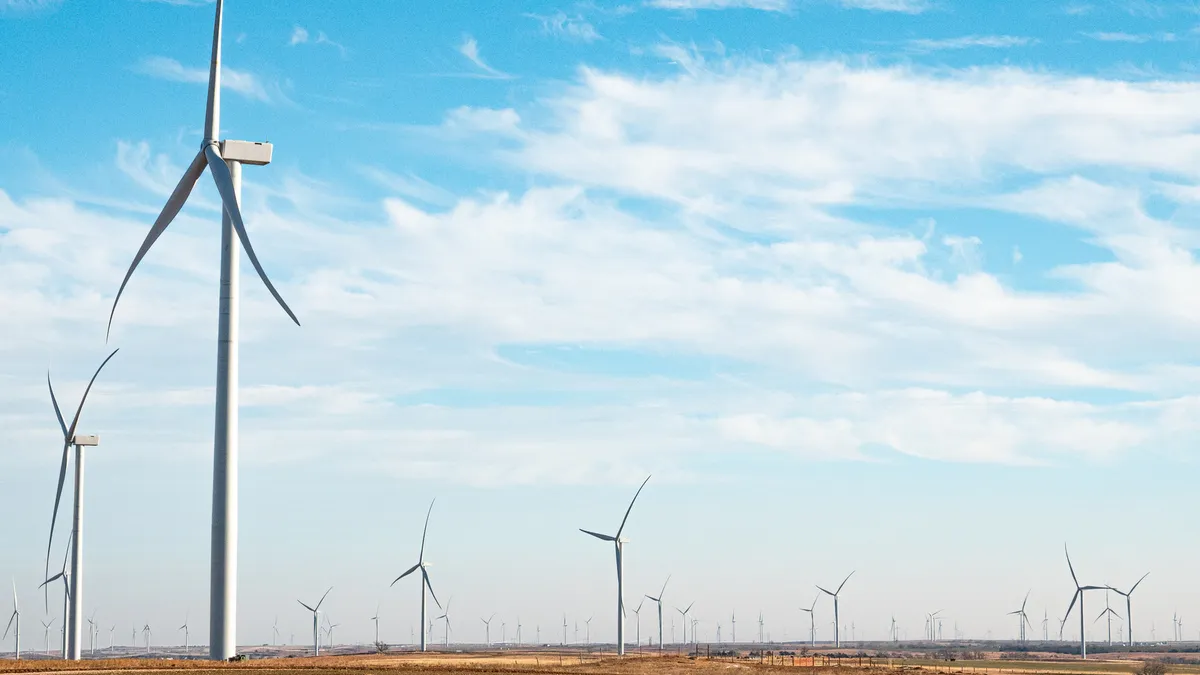Dive Brief:
-
American Electric Power's Traverse Wind Energy Center, the company's largest wind farm at 998 MW, has begun operations, according to an announcement from the company.
-
The project, in Blaine and Custer counties in Oklahoma, is the final addition to the three-part North Central Energy Facilities, which will generate a combined 1,484 MW of clean energy at a total cost of $2 billion.
-
With the North Central project now complete, AEP is "moving pretty aggressively" to acquire another 14.5 GW of renewable energy by 2030, according to Antonio Smyth, senior vice president of grid solutions for AEP.
Dive Insight:
AEP's newest Traverse Wind Energy Center, the company's largest wind farm to date, is only the beginning of the company's renewable energy ambitions, according to Smyth.
AEP, with developer Invenergy, was able to complete the 356-turbine Traverse project in about a year and a half, pandemic notwithstanding, Smyth said. Together with two other North Central Energy Facilities, the 199-MW Sundance and 287-MW Maverick wind projects, Traverse is expected to save customers in Oklahoma, Arkansas and Louisiana $3 billion over 30 years.
But the now-complete North Central Energy initiative was merely the first step toward AEP's goal of deploying 16 GW of new wind and solar energy by 2030, which will be needed to fill gaps left by upcoming retirements of older generating units, Smyth said. AEP has recently filed for approval of additional projects through its Southwestern Electric Power Company and Appalachian Power affiliates, and is actively on the market with requests for proposals in Oklahoma and Indiana, he said.
"We're in the market pretty aggressively right now with some large scale RFPs, and we will continue to do that," Smyth said. "We're going to continue to file integrated resource plans and RFPs in an effort to hit that goal in the next decade. ... It's going to take a big effort to achieve that goal, but it's achievable and we're going after it."
While the Traverse project demonstrates the technical potential for gigawatt-scale wind and solar projects, it's not likely that projects of this size will become the norm, Smyth said. But given the growth of renewables, he said, it's possible that Traverse's 998 MW record could one day fall to a future development.
"The technology is there to develop to scale, so I don't think that's a limiting step, but from a development perspective, putting continuous parcels of land together at this scale can be a challenge," Smyth said. "But as the demand in the market picks up, we may see larger projects available."
And like other utilities, AEP plans to add dramatically to that demand in years to come — the company announced in February 2021 that it aims to achieve net-zero carbon emissions by 2050 after cutting emissions 80% by 2030.
"In order to achieve our goal, we're going to have to bring online large volumes of renewables," Smyth said, "but it remains to be seen whether that occurs with a basket of smaller projects, or some larger projects sprinkled in there to take care of the need."














